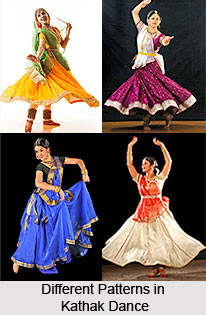 Dance patterns in Kathak are successive in nature and are named according to the varying degree of the complexity of the rhythmic pattern or on account of the mnemonics used. The tukra is a pure dance pattern which is the simplest variety where the mnemonics are of the Tabla. Tora is a formalized pattern that takes only a few types of mnemonics into consideration. Parana is a dance pattern which is performed to the mnemonics of pakhavaj.
Dance patterns in Kathak are successive in nature and are named according to the varying degree of the complexity of the rhythmic pattern or on account of the mnemonics used. The tukra is a pure dance pattern which is the simplest variety where the mnemonics are of the Tabla. Tora is a formalized pattern that takes only a few types of mnemonics into consideration. Parana is a dance pattern which is performed to the mnemonics of pakhavaj.Thereafter the performance of tora is that of the tukra which is often presented as the chakkardar tukra. These are built in the same manner as the tirmanams of the varnam in Bharatnatyam. The dancer begins with a slow rhythmic pattern in vilambit laya. This is finally presented in a double or a triple laya. Here there is a successive progression and the relationship of the third laya to the first laya varies significantly. The entire sequence is repeated in multiples of three. The structure is built on an accurate mathematical sense. The dancer's skill lies in building up this structure from the first beat of the rhythmic pattern or from any of the subsequent beats. The rule is that the dancer must end on the last beat of the metrical cycle or the first beat of the new cycle. The Parana is a dance pattern which is executed to the mnemonics with heavy and echoing aspirant sounds.
Kathak's Nritta technique can be covered under these divisions. The tukras, the toras and the paranas have their subdivisions. One such classification is the composition which comprises sounds of various musical instruments known to north Indian music, such as, the nagara, pakhavaj and so on. It has also been defined as a category which has a combination of the Tandava and the Lasya styles. There are tukras which are known as the Sangeet ka tukras. These are compositions of one syllable or two syllables each, but with some musical quality about them. The common Sangeet ka tukra from the Jaipur School is 'drig jagira drig jagira.' The Nritta portions are presented to a repetitive melodic line known as the nagma. Both the drummer and the dancer make endless variety of rhythmic combinations on this melodic line. The synchronization is all in the sphere of the metrical cycle.
For more, visit the link below: